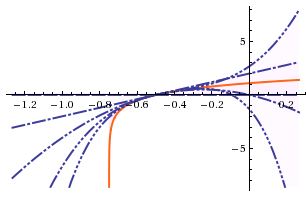

Use the point






Set







For  the series expansion results in,
the series expansion results in,

Plots of taylor series expansion:
Up to order 4

Up to order 7

Up to order 11

Up to order 16

The visually estimated domain of convergence is from .8 to .2.
Now use the transformation of variable


If  has a domain of convergence from
has a domain of convergence from ![{\displaystyle [-1,+1]}](https://wikimedia.org/api/rest_v1/media/math/render/svg/daa72f1a806823ec94fda7922597b19cbda684f4) then
then  converges from
converges from ![{\displaystyle [{\frac {-3}{4}},{\frac {-1}{4}}]}](https://wikimedia.org/api/rest_v1/media/math/render/svg/c7963189a61117f0b3b530b0dac055300b6c4e0e)
On our honor, we solved this problem on our own, without aid from online solutions or solutions from previous semesters.
Plot at least 3 truncated series to show convergence

m=0:
m=1:
m=2:

Plot at least 3 truncated series to show convergence

m=0:
m=1:
m=2:

Find the radius of convergence for the taylor series of sinx, x = 0
The Taylor series of sinx is:

The radius of convergence can be found by:
![{\displaystyle R_{c}=[lim\left|{\frac {d_{k+1}}{d_{k}}}\right|]^{-1}}](https://wikimedia.org/api/rest_v1/media/math/render/svg/253e55d414767ffed2bb304def1691ecae2a32f4)
![{\displaystyle R_{c}=[lim{\frac {(-1)^{m+1}}{(2m+3)!}}*{\frac {(2m+1)!}{(-1)^{m}}}]^{-1}}](https://wikimedia.org/api/rest_v1/media/math/render/svg/391d36bc79242f468a7992cee6f1990425c64054)

Find the radius of convergence for the taylor series of log(1+x), x = 0
The Taylor series of log(x+1) is:

The radius of convergence can be found by:
![{\displaystyle R_{c}=[lim\left|{\frac {d_{k+1}}{d_{k}}}\right|]^{-1}}](https://wikimedia.org/api/rest_v1/media/math/render/svg/253e55d414767ffed2bb304def1691ecae2a32f4)
![{\displaystyle R_{c}=[lim{\frac {(-1)^{n+1}}{n+1}}*{\frac {n}{(-1)^{n}}}]^{-1}}](https://wikimedia.org/api/rest_v1/media/math/render/svg/18af28d2aff6507b39038376762068f59a891d0d)

Find the radius of convergence for the taylor series of log(1+x), x = 1
The Taylor series of log(x+1) is:

The radius of convergence can be found by:
![{\displaystyle R_{c}=[lim\left|{\frac {d_{k+1}}{d_{k}}}\right|]^{-1}}](https://wikimedia.org/api/rest_v1/media/math/render/svg/253e55d414767ffed2bb304def1691ecae2a32f4)
![{\displaystyle R_{c}=[lim{\frac {(-1)^{n+1}}{n+1}}*{\frac {n}{(-1)^{n}}}]^{-1}}](https://wikimedia.org/api/rest_v1/media/math/render/svg/18af28d2aff6507b39038376762068f59a891d0d)

derive the expression for the radius of convergence of log(1+x) about any focus point
The taylor series of log(1+x) is:

![{\displaystyle R_{c}=[{\frac {(-1)^{n+1}({\widehat {x}})^{n+1}}{n+1}}*{\frac {n}{(-1)^{n}({\widehat {x}})^{n}}}]^{-1}}](https://wikimedia.org/api/rest_v1/media/math/render/svg/7ca84679b80455b67b749976604a1b073d4d063d)
Find the Taylor series representation of log(3+4x)

Expanding out 4 terms results in,
[

The series representation is

Radius of convergence of log(3+4x) about the point 


![{\displaystyle R_{c}=lim_{n\rightarrow \infty }[{(-1)^{n+2}}{\frac {4^{n+1}}{n+1}}(.25)^{n+1}*{\frac {n}{4^{n}(-1)^{n+1}(.25)^{n}}}]^{-1}}](https://wikimedia.org/api/rest_v1/media/math/render/svg/d506acc8526199c6f45e4f0d3409e7ef8d96696c)
Cancelling some terms out, you get

Using L'Hopitals Rule, you get

Radius of convergence of log(3+4x) about the point 


![{\displaystyle R_{c}=lim_{n\rightarrow \infty }[{(-1)^{n+2}}{\frac {4^{n+1}}{n+1}}(.0625)^{n+1}*{\frac {n}{4^{n}(-1)^{n+1}(.0625)^{n}}}]^{-1}}](https://wikimedia.org/api/rest_v1/media/math/render/svg/46d601d38f89e339d6c97d2e24ff3748df3a7743)
Cancelling some terms out, you get

Using L'Hopitals Rule, you get

Radius of convergence of log(3+4x) about the point 


![{\displaystyle R_{c}=lim_{n\rightarrow \infty }[{(-1)^{n+2}}{\frac {4^{n+1}}{n+1}}(1)^{n+1}*{\frac {n}{4^{n}(-1)^{n+1}(1)^{n}}}]^{-1}}](https://wikimedia.org/api/rest_v1/media/math/render/svg/62f43e8da697a74de61704b8583665c40591e88f)
Cancelling some terms out, you get

Using L'Hopitals Rule, you get

Radius of convergence of log(3+4x) about any given point 

![{\displaystyle R_{c}=lim_{n\rightarrow \infty }[{(-1)^{n+2}}{\frac {4^{n+1}}{n+1}}({\widehat {x}}^{2})^{n+1}*{\frac {n}{4^{n}(-1)^{n+1}(({\widehat {x}}^{2})^{n})}}]^{-1}}](https://wikimedia.org/api/rest_v1/media/math/render/svg/b234a8da29509a9e50b4f5235db2a15cfda7701b)
On our honor, we solved this problem on our own, without aid from online solutions or solutions from previous semesters.
Use the Determinant of the Matrix of Components and the Gramian to verify the linear independence of the two vectors  and
and  .
.


The Matrix of components of the vectors  and
and  is
is

So the vectors  and
and  are linearly independent.
are linearly independent.
For vectors, the Gramian is defined as:

where:

For the given vectors, the dot products are:




So the Gramian matrix becomes:

Finding the determinant of the Gramian matrix gives the Gramian:

So the vectors  and
and  are linearly independent.
are linearly independent.
On our honor, we solved this problem on our own, without aid from online solutions or solutions from previous semesters.
Use both the Wronskian and the Gramain to find whether the following functions are linearly independent. Consider the domain of these functions to be [-1, +1] for the construction of the Gramian matrix.


Wronskian:

Function is linearly independent if 
1) 


 so function is linearly independent.
so function is linearly independent.
2)


 so function is linearly independent.
so function is linearly independent.
Gramian:

Function is linearly independent if 
1) 




 so function is linearly independent.
so function is linearly independent.
2) 

![{\displaystyle <f,g>=\int _{-1}^{1}cos2x*sin4xdx=[.5cos^{2}x-1/12cos6x]_{-}^{1}1=0}](https://wikimedia.org/api/rest_v1/media/math/render/svg/bcc0b0f66c5db6963268fc427cb89653a6a5e46c)


 so function is linearly independent.
so function is linearly independent.
On our honor, we solved this problem on our own, without aid from online solutions or solutions from previous semesters.





















![{\displaystyle [-1,+1]}](https://wikimedia.org/api/rest_v1/media/math/render/svg/daa72f1a806823ec94fda7922597b19cbda684f4)
![{\displaystyle [{\frac {-3}{4}},{\frac {-1}{4}}]}](https://wikimedia.org/api/rest_v1/media/math/render/svg/c7963189a61117f0b3b530b0dac055300b6c4e0e)










![{\displaystyle R_{c}=[lim\left|{\frac {d_{k+1}}{d_{k}}}\right|]^{-1}}](https://wikimedia.org/api/rest_v1/media/math/render/svg/253e55d414767ffed2bb304def1691ecae2a32f4)
![{\displaystyle R_{c}=[lim{\frac {(-1)^{m+1}}{(2m+3)!}}*{\frac {(2m+1)!}{(-1)^{m}}}]^{-1}}](https://wikimedia.org/api/rest_v1/media/math/render/svg/391d36bc79242f468a7992cee6f1990425c64054)


![{\displaystyle R_{c}=[lim{\frac {(-1)^{n+1}}{n+1}}*{\frac {n}{(-1)^{n}}}]^{-1}}](https://wikimedia.org/api/rest_v1/media/math/render/svg/18af28d2aff6507b39038376762068f59a891d0d)



![{\displaystyle R_{c}=[{\frac {(-1)^{n+1}({\widehat {x}})^{n+1}}{n+1}}*{\frac {n}{(-1)^{n}({\widehat {x}})^{n}}}]^{-1}}](https://wikimedia.org/api/rest_v1/media/math/render/svg/7ca84679b80455b67b749976604a1b073d4d063d)




![{\displaystyle R_{c}=lim_{n\rightarrow \infty }[{(-1)^{n+2}}{\frac {4^{n+1}}{n+1}}(.25)^{n+1}*{\frac {n}{4^{n}(-1)^{n+1}(.25)^{n}}}]^{-1}}](https://wikimedia.org/api/rest_v1/media/math/render/svg/d506acc8526199c6f45e4f0d3409e7ef8d96696c)




![{\displaystyle R_{c}=lim_{n\rightarrow \infty }[{(-1)^{n+2}}{\frac {4^{n+1}}{n+1}}(.0625)^{n+1}*{\frac {n}{4^{n}(-1)^{n+1}(.0625)^{n}}}]^{-1}}](https://wikimedia.org/api/rest_v1/media/math/render/svg/46d601d38f89e339d6c97d2e24ff3748df3a7743)




![{\displaystyle R_{c}=lim_{n\rightarrow \infty }[{(-1)^{n+2}}{\frac {4^{n+1}}{n+1}}(1)^{n+1}*{\frac {n}{4^{n}(-1)^{n+1}(1)^{n}}}]^{-1}}](https://wikimedia.org/api/rest_v1/media/math/render/svg/62f43e8da697a74de61704b8583665c40591e88f)




![{\displaystyle R_{c}=lim_{n\rightarrow \infty }[{(-1)^{n+2}}{\frac {4^{n+1}}{n+1}}({\widehat {x}}^{2})^{n+1}*{\frac {n}{4^{n}(-1)^{n+1}(({\widehat {x}}^{2})^{n})}}]^{-1}}](https://wikimedia.org/api/rest_v1/media/math/render/svg/b234a8da29509a9e50b4f5235db2a15cfda7701b)































![{\displaystyle <f,g>=\int _{-1}^{1}cos2x*sin4xdx=[.5cos^{2}x-1/12cos6x]_{-}^{1}1=0}](https://wikimedia.org/api/rest_v1/media/math/render/svg/bcc0b0f66c5db6963268fc427cb89653a6a5e46c)


